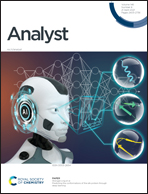Location of carbon–carbon double bonds in unsaturated lipids using microdroplet mass spectrometry†
Abstract
An aqueous solution containing unsaturated fatty acids (100 μM) or lipids (50 μg mL−1) and chloroauric acid (HAuCl4, 10 μM) is electrosprayed (−4.5 kV for unsaturated fatty acids and +4.0 kV for lipids) from a 50 μm diameter capillary with N2 nebulizing gas (60 psi), and the resulting microdroplets enter a mass spectrometer with a flight distance of 10 mm for chemical analysis. The HAuCl4 oxidizes the C![[double bond, length as m-dash]](https://www.rsc.org/images/entities/char_e001.gif) C double bond to cause the formation of an aldehyde group or a hydroxyl group on one side and a carboxyl group on the other (i.e., CHO-R-COOH or HO-R-COOH), allowing the location of the double bond to be identified. This approach was successfully applied to four unsaturated fatty acids [linoleic acid (LA), ricinoleic acid (RA), isooleic acid (IA), and nervonic acid (NA)] and two phospholipids [1,2-dioleoyl-sn-glycero-3-phosphocholine (DOPC) and L-α-lysophosphatidylcholine (lysoPC)]. A mechanism for this transformation is proposed, which involves epoxidation of the double bond, followed by the formation of the final products. This method has the advantages of being simple and rapid, and requiring a small amount of analyte.
C double bond to cause the formation of an aldehyde group or a hydroxyl group on one side and a carboxyl group on the other (i.e., CHO-R-COOH or HO-R-COOH), allowing the location of the double bond to be identified. This approach was successfully applied to four unsaturated fatty acids [linoleic acid (LA), ricinoleic acid (RA), isooleic acid (IA), and nervonic acid (NA)] and two phospholipids [1,2-dioleoyl-sn-glycero-3-phosphocholine (DOPC) and L-α-lysophosphatidylcholine (lysoPC)]. A mechanism for this transformation is proposed, which involves epoxidation of the double bond, followed by the formation of the final products. This method has the advantages of being simple and rapid, and requiring a small amount of analyte.

- This article is part of the themed collection: Analyst Recent HOT articles


 Please wait while we load your content...
Please wait while we load your content...